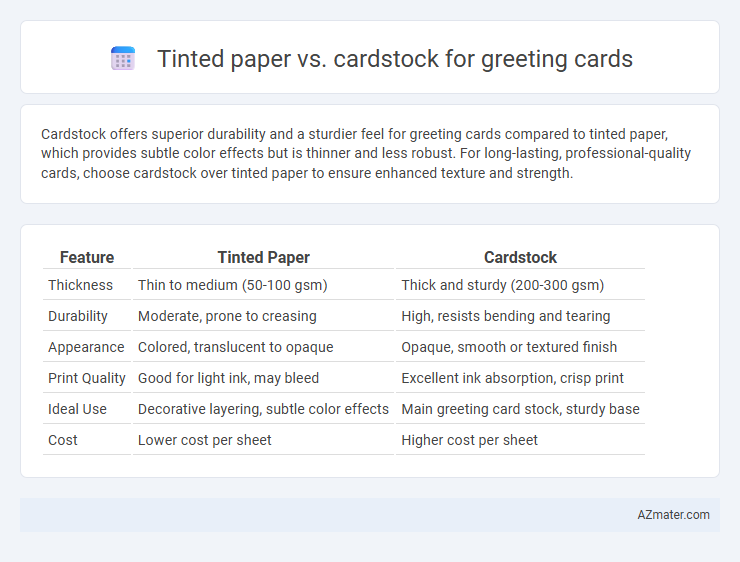Cardstock offers superior durability and a sturdier feel for greeting cards compared to tinted paper, which provides subtle color effects but is thinner and less robust. For long-lasting, professional-quality cards, choose cardstock over tinted paper to ensure enhanced texture and strength.
Table of Comparison
| Feature | Tinted Paper | Cardstock |
|---|---|---|
| Thickness | Thin to medium (50-100 gsm) | Thick and sturdy (200-300 gsm) |
| Durability | Moderate, prone to creasing | High, resists bending and tearing |
| Appearance | Colored, translucent to opaque | Opaque, smooth or textured finish |
| Print Quality | Good for light ink, may bleed | Excellent ink absorption, crisp print |
| Ideal Use | Decorative layering, subtle color effects | Main greeting card stock, sturdy base |
| Cost | Lower cost per sheet | Higher cost per sheet |
Introduction to Tinted Paper and Cardstock
Tinted paper offers subtle color variations that enhance the visual appeal of greeting cards while maintaining a lightweight and flexible texture ideal for intricate folds and detailed designs. Cardstock features a thicker, sturdier composition that provides durability and a premium feel, making it suitable for high-quality, long-lasting greeting cards. Selecting between tinted paper and cardstock depends on the desired aesthetic and functional requirements of the card, balancing elegance with structural integrity.
Material Composition and Properties
Tinted paper for greeting cards is typically lightweight with a smooth finish, composed mainly of wood pulp and infused with dye to achieve its distinct color, offering moderate opacity and flexibility suited for detailed printing and folding. Cardstock consists of thicker, more rigid fibers, often including cotton or synthetic blends, providing enhanced durability, stiffness, and a higher weight basis measured in gsm (grams per square meter), ideal for sturdy, long-lasting cards. The higher density and texture of cardstock reduce transparency and increase tactile quality, while tinted paper prioritizes vibrant color options with lighter structural integrity.
Texture and Visual Appeal
Tinted paper offers a smooth texture with subtle color variations that enhance the visual depth of greeting cards, providing a soft, elegant look. Cardstock features a heavier, more rigid texture that creates a sturdy and luxurious feel, making colors appear more vibrant and the design elements more pronounced. Choosing between the two depends on whether a delicate, visually nuanced finish or a bold, tactile statement is desired for the card's overall aesthetic.
Color Variety and Customization
Tinted paper offers an extensive color variety that enhances the visual appeal of greeting cards with vibrant, subtle, or pastel shades, allowing for artistic and thematic customization. Cardstock provides a more limited color range but compensates with a sturdy texture that supports advanced customization techniques like embossing, foil stamping, and die-cutting. Selecting between tinted paper and cardstock depends on whether color variety or tactile customization is the priority for the greeting card design.
Durability and Thickness Comparison
Tinted paper typically offers moderate thickness around 80-100 gsm, making it less durable and prone to bending or creasing compared to cardstock. Cardstock ranges from 200-300 gsm, providing superior sturdiness and resistance to wear, ideal for greeting cards requiring long-lasting quality. The thickness and rigidity of cardstock enhance the card's professional feel and durability, especially when mailed or handled frequently.
Printing and Design Compatibility
Tinted paper offers subtle color variations that enhance printed designs with a soft, elegant background, ideal for delicate text and light graphics. Cardstock provides a thicker, sturdier surface suited for bold prints and intricate patterns, ensuring durability and vibrant color reproduction in greeting cards. Both materials support inkjet and laser printing, but cardstock's weight better accommodates embossing and die-cutting techniques for advanced design compatibility.
Cost and Availability
Tinted paper offers a budget-friendly option for greeting cards, often available in a variety of colors at low costs in most office supply stores. Cardstock, while generally more expensive due to its thicker and sturdier quality, is widely available in specialty paper shops and online retailers offering diverse textures and weights. Cost-savvy creators choose tinted paper for its affordability, whereas those seeking durability and premium feel prioritize cardstock despite higher prices.
Eco-friendliness and Sustainability
Tinted paper and cardstock both offer eco-friendly options for greeting cards when sourced from recycled or FSC-certified materials. Cardstock's thicker and more durable composition typically ensures longevity and reusability, reducing waste over time. Choosing vegetable-based inks and acid-free, biodegradable tinted paper can further enhance sustainability by minimizing environmental impact.
Suitability for Special Occasions
Cardstock offers superior durability and a premium feel, making it ideal for special occasion greeting cards that require a lasting impression. Tinted paper provides subtle color variations, adding elegance and visual interest suitable for events like birthdays or weddings. Choosing cardstock delivers sturdiness for keepsakes, while tinted paper enhances aesthetic appeal with softer, colorful backgrounds.
Choosing the Best Option for Your Greeting Cards
Tinted paper offers a subtle, colored background that enhances the visual appeal of greeting cards with light to medium ink coverage, making it ideal for elegant, understated designs. Cardstock provides greater durability and thickness, ensuring the greeting card feels substantial and withstands handling, especially suitable for intricate patterns or heavy embellishments. Selecting between tinted paper and cardstock depends on the desired texture, visual impact, and the card's intended use or recipient experience.

Infographic: Tinted paper vs Cardstock for Greeting card
 azmater.com
azmater.com